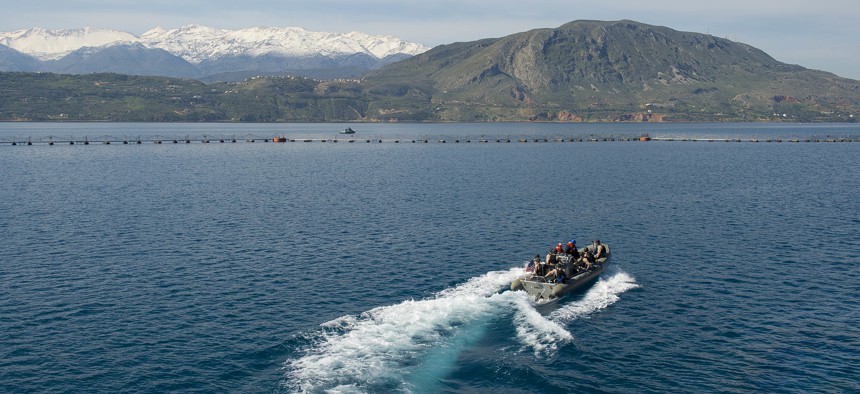
SOUDA BAY, Greece (April 13, 2015) The The USS Ross (DDG 71) visit board search and seizure (VBSS) team trains in the port of Souda Bay, Greece April 13, 2015. U.S. Navy photo by Mass Communication Specialist 3rd Class Robert S. Price
Time for a US Maritime Security Strategy for Europe
Congress should require DOD to develop one along the lines of the recent Asia Pacific Maritime Security Strategy.
The U.S. and its NATO allies need a new strategy for the maritime domains in and around Europe, which are contested and congested in ways that were almost unthinkable a few years ago. Fortunately, there is a good model available: the Defense Department’s new Asia Pacific Maritime Security Strategy.
One spur is Russia, whose recent assertiveness against U.S. friends, allies, and partners in Europe has been expressed on, above, and under the sea. In the Barents Sea, the Russian Navy is modernizing its fleets of attack and ballistic missile submarines. In the Baltic and Black Seas, Moscow is operating aircraft and ships at an increasing pace and arraying a robust anti-access/area denial capability. Russia also recently revised its own maritime strategy to emphasize not just its Arctic ambitions, but access to and the ability to operate in the Atlantic.
The Mediterranean offers different and no less serious challenges. Migrants and refugees from Africa and the Middle East are almost overwhelming European navies and maritime law-enforcement entities; they also constitute a longer-term challenge to these nations’ sovereignty and economies. And if the breakdown of governance and order across the Mediterranean’s southern rim leads the United States and its allies to intervene again, their actions would surely have maritime components.
The good news is that there is an available model for bringing clarity to maritime operations. DOD recently published the congressionally mandated Asia Pacific Maritime Security Strategy (APMSS), a valuable document that describes an evolving maritime security environment. Important and timely in light of the U.S. rebalance to the Indo-Asia-Pacific region and concerns about Chinese assertiveness in the South China Sea and elsewhere, it makes a cogent case for safeguarding freedom of the seas to help deter conflict and coercion, and identifies DoD lines of effort to accomplish these ends.
Following up the APMSS with a European Maritime Security Strategy will leverage the intellectual investment in the earlier effort, and should improve the balancing of U.S. forces globally by avoiding a soda-straw look at only one region of the world. It should follow the lines of effort identified in the APMSS: strengthening U.S. Navy capacity, building ally and partner capacity, reducing risk, and building regional architecture and supporting rule of law.
Regarding strengthening capacity, while the U.S. Navy is certainly committed to the Asian rebalance, it also recently sent four guided missile destroyers to new homeports in Rota, Spain. Congress and the public would benefit from a statement of our maritime capacity in Europe.
In resource-constrained times, a discussion of how we work together with our NATO allies and non-NATO European partners in maritime security efforts and bolstering allied naval warfighting capacities is more important than ever. Reducing and mitigating risk and building regional security architectures are similarly important.
Much suggests that the 21st century will be maritime in nature. But that is not solely driven by the significance of the Asia-Pacific region. Other competitors are increasingly challenging the United States and its friends and allies at sea too. As part of the U.S. response, Congress should instruct the Pentagon to define a maritime strategy for Europe.
NEXT STORY: Seven Things Our Army Needs, Right Now



